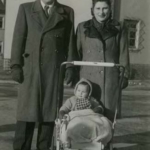Black History Museum Planned at Naples Depot

Jeff lytle
After serving as a freight and passenger terminal starting in 1927 and later a museum telling Collier County’s story, and serving as the backdrop for the dedication of a Holocaust era boxcar in 2008, the depot is working on launching the county’s first museum dedicated to Black history.
The project, launched quietly last year, when Hurricane Ian damaged the depot, seeks to convert an underused Pullman baggage train car already at the site. It was left there by one of two rail lines which came in and out of the depot until the late 1970s.
 William Dwight, president of the supportive Friends of the Collier County Museum, says the Pullman is appropriate because Blacks built the rail cars and served as porters.
William Dwight, president of the supportive Friends of the Collier County Museum, says the Pullman is appropriate because Blacks built the rail cars and served as porters.
Project leaders say their efforts can carry on while hurricane repairs continue at the depot.
Collier County Museums Director Amanda Townsend says the Black history story is linked to county founder Barron Gift Collier and his construction of the Tamiami Trail, where Blacks were among his “multicultural workforce.”
The history also goes back to workers in the logging camps and sawmills in remote eastern Collier, she says.
In the city of Naples, she instructs, Blacks resided in the Ditch Bank settlement that now is Crayton Cove and worked at the Naples Hotel. They moved to McDonald’s Quarters shantytown in Central Naples, where squalid, unhealthy conditions rallied community leaders to champion its demolition in 1980. Slum residents relocated to today’s nearby George Washington Carver Complex.
Other Blacks, Townsend says, lived in the South Side of Immokalee and worked in agriculture.
“African Americans made a living and lives for themselves in our communities,” she says, “and those stories are worthy of deeper understanding and telling.
“We can put those local stories in context against the backdrop of the baggage car and what the railroad industry meant for social mobility for African Americans throughout the country in the 20th century.”
 Vincent Keeys, president of the Collier County NAACP, adds his perspective. “This community is the crown jewel of winter retreats but it is void of any kind of cultural centers,” he says. “History has gone out of its way to erase particular pioneers that deserve recognition. The Naples Depot understands this very well and we would like to share local Black history with our community.”
Vincent Keeys, president of the Collier County NAACP, adds his perspective. “This community is the crown jewel of winter retreats but it is void of any kind of cultural centers,” he says. “History has gone out of its way to erase particular pioneers that deserve recognition. The Naples Depot understands this very well and we would like to share local Black history with our community.”
Dwight says he hopes to maintain the exterior look of the car while renovating the inside, which would include handicap access and air conditioning.
“I would very much like for the car to feature an oral history booth so that we could continue to gather stories from people who live in the community today,” Townsend says. Dwight hopes to work with local PBS station WGCU to videotape interviews, to supplement photos, artifacts and paintings.
“We already have a few important pieces in our collection — such as moving company founder Cleveland Bass’ hand truck and scale recently donated by his family — that would be perfect to display in the car,” Townsend says.
She targets a total budget of $600,000-$650,000. Dwight says initial grants of $400,000 from the state plus $50,000 from the city of Naples, plus donations of $55,000, are in hand. The county, he says, has yet to be approached.
 While lacking a firm deadline, Townsend hopes to open as soon as possible with semi-permanent displays, then work on collecting more stories and artifacts, then more permanent exhibits. “It will be wonderful to let it evolve with the community’s input,” she says.
While lacking a firm deadline, Townsend hopes to open as soon as possible with semi-permanent displays, then work on collecting more stories and artifacts, then more permanent exhibits. “It will be wonderful to let it evolve with the community’s input,” she says.
Townsend reflects on how much of early Black history took place out of the public eye, in places that were in the wilderness and barely exist today. For example, she says Barron Collier’s lumber mill was in DuPont, Everglades City’s Black neighborhood, and later moved north of Carnestown.
In the 1920s and 1930s, she says, the logging was mostly pine, “and it was common to disassemble and move a mill and the camps when an area had been depleted of timber.
 “In the 1940s and 1950s, with more access and heavier equipment, cypress began to be logged out of more remote areas. More permanent mills were established at Copeland and Jerome. Narrow-gauge railroad spurs were run into the Big Cypress to extract the timber and transport it to the mill.
“In the 1940s and 1950s, with more access and heavier equipment, cypress began to be logged out of more remote areas. More permanent mills were established at Copeland and Jerome. Narrow-gauge railroad spurs were run into the Big Cypress to extract the timber and transport it to the mill.
“Both Copeland and Jerome had segregated housing for Black workers and their families.”
Looking ahead, she believes the history project will make history of its own. “I don’t know of any other community,” she says, “that has specifically used a train car for a Black history exhibit.” Collier




Leave a Reply
Want to join the discussion?Feel free to contribute!